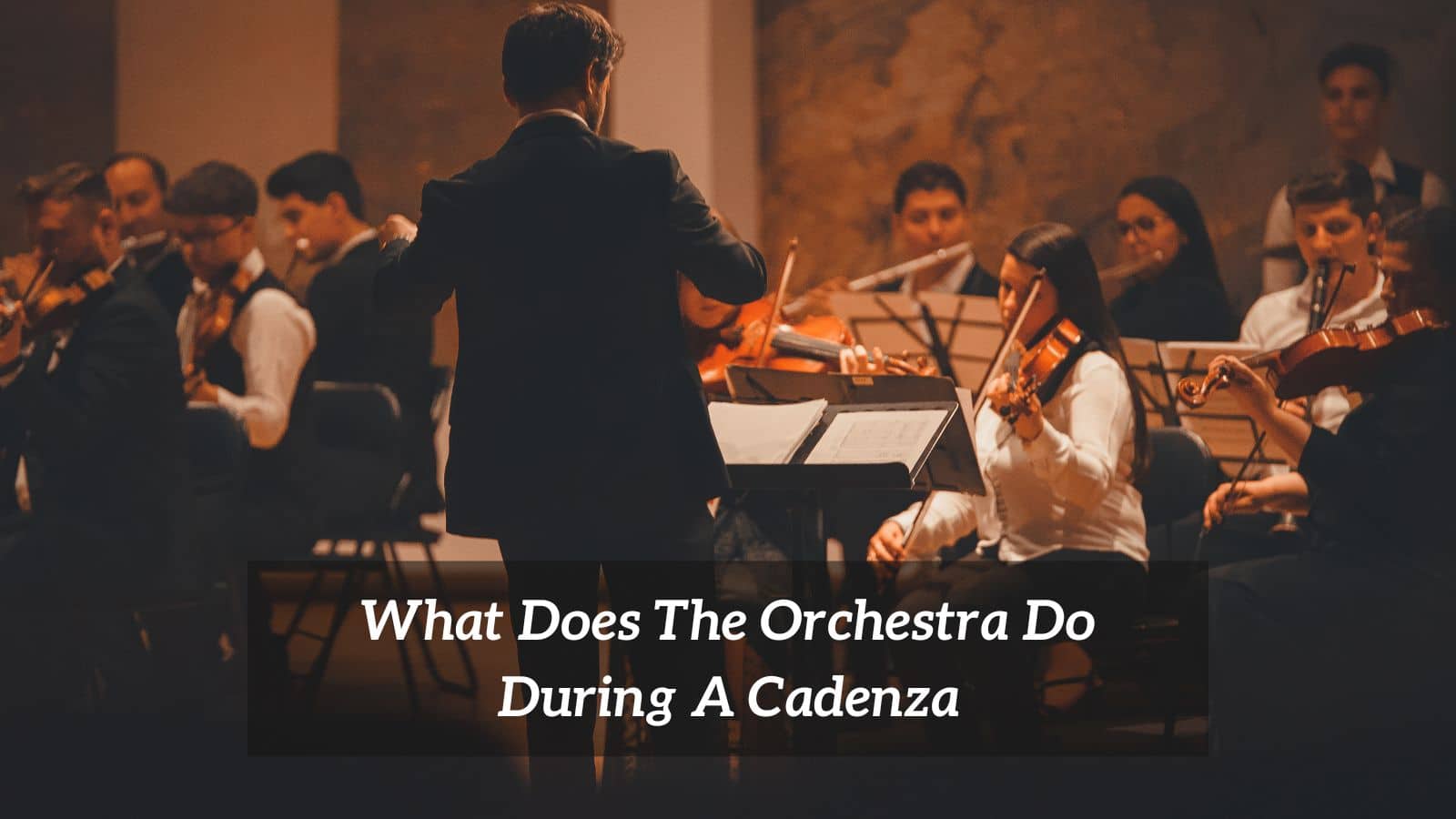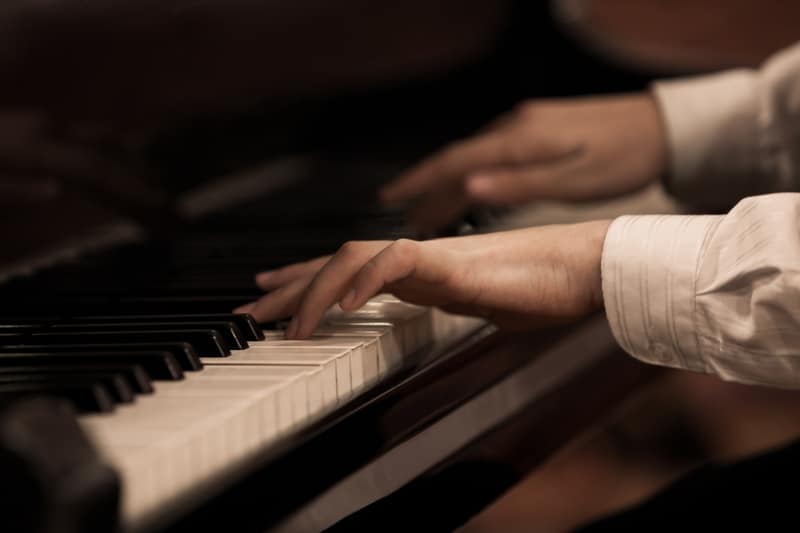
A key element of this title above is what is a cadenza. The answer to this sensible question is a gigantic clue to the answer to the title of the piece, although not everything is quite as it may seem.
If we are looking for examples of a cadenza we are probably selecting pieces that fall into the category of a concerto. In summary, a concerto is a piece, usually in three or four movements, for a soloist and an orchestra.
Contemporary variations exist to this classic model for a concerto, but for now, we will adopt this as our beginning.
What Does The Orchestra Do During A Cadenza
For many concertos that originate in the Classical period of music, the cadenza would often be placed at the end or in the middle part of the slow movement.
Keep in mind that the common tempo used for the three-movement form would be fast; slow; fast. The cadenza sometimes joined the slow movement to the finale.
What happens in a cadenza is the soloist has the opportunity to demonstrate their technical wizardry. Yes, that is sort of the concept that drives the concerto, but the difference is that in the cadenza the soloist frequently is required to improvise.
This improvisation is supposed to be based on the thematic material of that movement. In this way, the soloist can elaborate, develop, and extend the thematic ideas the composer has provided in new and dexterous ways.
Some cadenzas are written by the composer already. Take the Beethoven piano concertos. Each of these has a cadenza composed by Beethoven that is probably as good as it gets both in terms of flawless improvisation and in terms of being stylistically perfect.
Interestingly, the opening of Beethoven’s Fifth Piano Concerto is a cadenza composed by Beethoven. It opens the entire work with the orchestra simply providing a tutti chord for each phase of the cadenza. This was a major departure from the structure of the concerto, as well as the purpose of the cadenza itself.
For these concertos, in particular, Beethoven was redefining the role of the soloist as well as radically altering what a cadenza could be used for.
As a result of opening the entire work with the piano soloist, Beethoven cleverly cast the piano as the protagonist or the hero, who posed the questions, fought with and engaged in dialogue with the orchestra in a totally new way.
Diving back into the Classical Era, a fine example of a concerto by WA Mozart was also one of his last. The Clarinet Concerto K.622 in A was composed for the renowned clarinettist and friend of WA Mozart’s, Anton Stadler.
As you might expect from a classical concerto, three movements follow the fast-slow-fast structure. The cadenza appears in the second movement at bar 59 (depending on your version of the score).
The orchestra comes to rest with the solo clarinet on a dominant seventh chord; which in this case is the chord of A7.
There is then a complete pause for the orchestra whilst the clarinettist takes a very short time to play the cadenza that neatly leads us back to the tonic key of D. At this point, the orchestra re-joins the soloist and we hear the opening theme return.
This example illustrates what the orchestra commonly did at the point of the cadenza. As it is primarily a part of the concerto during which the soloist improvises, or appears to improvise, the orchestra is silent.
Even though they are not always playing during a cadenza it is important to realise that the players will not be switching off they will be watching the conductor for their cue to return to accompany the soloist.
In the case of some cadenzas, this can be a prolonged amount of time and as an orchestral player, if you were not paying full attention you might miss your entry altogether.
In the Baroque Era cadenzas were also a prevalent feature of concertos of all varieties. The 3rd ‘Brandenburg Concerto’ by JS Bach is a further illustration of the orchestra providing a cadence point from which the soloist then springs forth with an improvisation around those chords.
JS Bach was according to many accounts, a formidable improviser and did not, as far as we know, supply a cadenza for the soloist for this piece.
Instead, the composer would have expected a high level of competency and knowledge of convention to create their own cadenza while the orchestra waited in quiet reverence.
Some cadenzas as in Beethoven’s ‘Fifth Piano Concerto’ and Tchaikovsky’s ‘First Piano Concerto’, begin the whole work with the orchestra very much in a subservient position, poised to enter only when the soloist has completed their exposition.
In Edward Elgar‘s ‘Violin Concerto’ (Op.61), the cadenza arrives in the third movement. It isn’t announced in the way you might expect and in this cadenza, the orchestra accompanies the solo violin with a curious but effective combination of tremolo with pizzicato.
Stretching closer to the present day is the music of Karlheinz Stockhausen. Stockhausen was very much the enfant terrible of his day, composing astonishingly adventurous and extravagant works for unusual types of ensembles.
His work of 1955/56 titled ‘Zeitmasse’ was just such a venture and includes five tremendously avant-garde cadenzas that transcend anything you have probably encountered before.
For the vast majority of traditional cadenzas, the accompanying ensemble or orchestra remains silent. There are a few exceptions to the rule as is often the case particularly when you delve into the world of contemporary music and jazz.
The key aspect of the cadenza is that it offers a place for the soloist to let their hair down and show off with everything they have available to them, especially in the concertos from the Romantic Era.
Keeping in mind that the composers who wrote many of these wonderful works also played them and composed their own cadenzas too. They would have wanted a silent pause from the accompanying orchestra to demonstrate their phenomenal powers of improvisation.
You only need to look at the works of Rachmaninov, Liszt and Prokofiev to hear what I mean.

